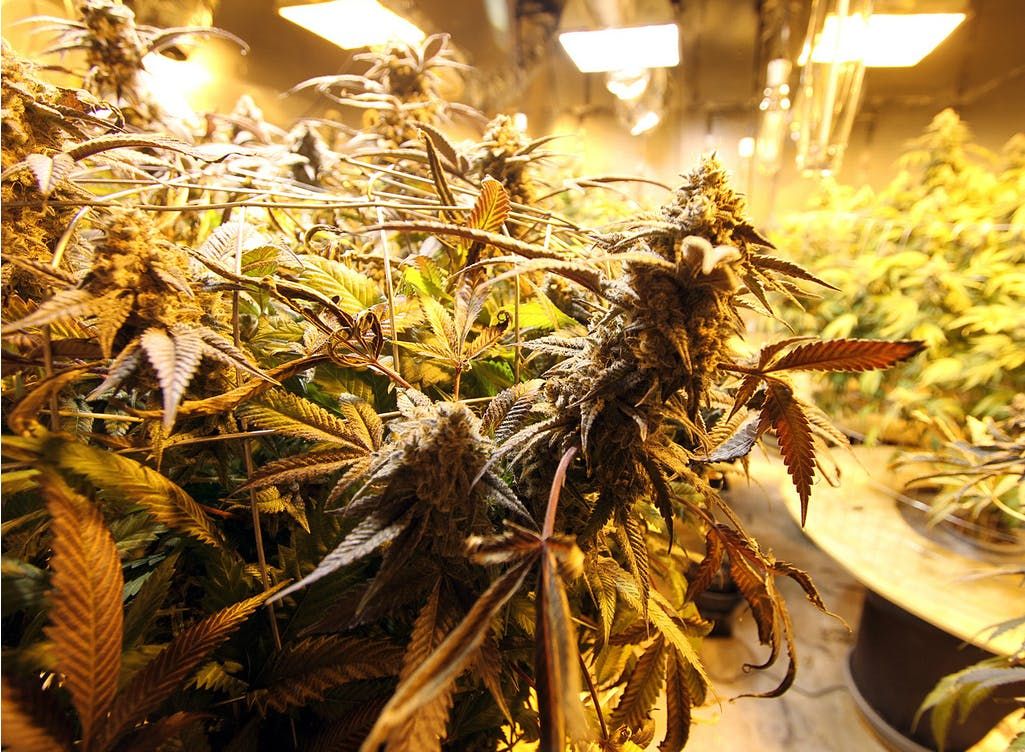Indoors, outdoors or greenhouse—if you’ve been to a medical marijuana dispensary lately, you may have noticed that there can be a big difference in pricing depending on how the cannabis was grown. Clients often ask me whether they should stick with cannabis grown by one of these methods. The truth is, there are reasons why any one of these common growing methods may gain favor in the eyes of a given individual. In this article, part of our series for cannabis newcomers, we’ll discuss how these different growing conditions can affect the cannabis produced.
FOLLOW US ON FACEBOOK & INSTAGRAM
Why Some Patients Will Pay More for Indoor-Grown Cannabis
One question new cannabis patients often ask me is why it costs more to purchase indoor cannabis over cannabis grown outdoors. For one, it simply costs more to produce indoor-grown cannabis. While outdoor-grown cannabis relies on natural resources like the sun and soil, an indoor grow requires significant monetary resources to build, install and run things like the physical structure, lighting, air-conditioning and dehumidifiers, soil or hydroponic equipment, irrigation system, fans, nutrients and more—all towards helping recreate the natural environment indoors. This artificial environment often comes with a steep price tag, one that’s passed on to the cannabis consumer.
Of course, the main reason why some patients are willing to spend more on indoor-grown marijuana products is the quality of the resulting medicine. In many respects, the controlled environment can result in higher-quality cannabis. Indoor grows protect cannabis from the harsh elements of the great outdoors. Cannabis can toughen up when exposed to wind and drastic temperature changes; it can also become pest-ridden and discolored by the sun.
In contrast, indoor cannabis flowers are usually more “kind.” This term means that the flower or bud of the plant is softer, tighter, denser as well as more colorful, crystal-covered, flavorful and aromatic. It can also mean that there’s a higher ratio of cannabinoids and terpenes relative to excess plant material.
While some argue that outdoor-grown cannabis can be just as kind and high quality as the indoor variety (and occasionally a cultivator in an ideal outdoor growing environment can and does produce very kind flower), some consumers still prefer indoor-grown cannabis, keeping demand—as well as prices—high for this type of plant.
The Downsides of Indoor-Grown Cannabis
On the down side, the controlled environment that makes indoor-grown cannabis so kind also relies on a lot of electricity. This means that indoor-grown marijuana isn’t always the most eco-friendly. Indoor grows also use artificial light to drive plant and resin growth; this method doesn’t have the same full spectrum of light that the sun, moon and stars can provide—these natural light sources are able to bring out a more complex array of terpenes and cannabinoids than is usually seen in indoor-grown cannabis. For those who prefer more complex terpene profiles, indoor-grown marijuana may be an inferior option to high-quality sungrown cannabis.
RELATED: GROWING MARIJUANA AT HOME
The Benefits of Outdoor-Grown Cannabis
In contrast to indoor cannabis, outdoor-grown plants tend to be available for much lower prices. Outdoor cannabis can use the natural environment for much of what it needs, and it can grow as much as the sun and nature’s available nutrients allow it to. This allows for cheaper prices, making it much more sustainable for patients who need to consume cannabis as an everyday medicine.
Price is one reason folks prefer outdoor-grown cannabis, but patients also often prefer the effects of the complex terpene and cannabinoid profiles brought out by natural light. For those more sensitive to the differences in these chemical components of cannabis, outdoor-grown marijuana may be a better option.
Outdoor cannabis also has a much lower carbon footprint than most indoor cannabis, because it doesn’t require the large electricity output that indoor-grown cannabis needs for lighting, cooling, dehumidifying and other systems. Patients concerned about the environmental impact of indoor grows often cite it as a reason for why they prefer outdoor-grown cannabis.
The Downsides of Outdoor-Grown Cannabis
That said, outdoor-grown cannabis isn’t environmentally friendly on all counts. Those concerned about sustainability and preserving the environment should be aware that while outdoor-grown cannabis is the best method for reducing your carbon footprint, it’s the absolute worst when it comes to conserving water. Sitting out in the full sun, these plants suck up a lot of water. As well, though some water will make it to the plant, the rest of it will evaporate or sink into the earth. Meanwhile, an indoor grow requires far less water due to its controlled environment.
Those concerned about the environment should be aware of the cons for each method of growing. Neither option is much better than the other. What it really comes down to is what resource you’re more interested in conserving.
In terms of quality, outdoor-grown cannabis can often grow larger, fluffier buds that aren’t as tight or densely packed with cannabinoids. These buds tend to be more weathered by factors like UV exposure, wind, pests and high temperatures than with those produced by other methods of growing.
The exposure to the elements can lead to tougher flower that’s discolored to look more brown or gray, with higher percentages of plant material and lipids. This can leave outdoor-grown flower tasting more grassy than indoor or greenhouse cannabis. While some outdoor grows can produce kind, incredibly well-grown flower that can almost pass for indoor-grown cannabis, outdoor cannabis continues to sell for less because of the loss in quality generally experienced in outdoor grows.
Reasons Why You May Prefer Greenhouse-Grown Cannabis
With this cultivation method, growers combine a partially controlled greenhouse environment with natural sunlight to produce flowers that hover between indoor and outdoor in terms of quality. Like the outdoors, greenhouses produce relatively large plants that have the complex array of terpenes and cannabinoids provided by full-spectrum light exposure.
Because it’s grown in a partially controlled environment, greenhouse flower can be kinder than outdoor cannabis. In other words, greenhouse flower tends to be smoother, more flavorful and more visually appealing than that of the outdoor variety, but not quite as much as indoor cannabis tends to be. With a price that’s also usually somewhere between the cost of indoor and outdoor marijuana, many find greenhouse cannabis to be a good compromise between quality and price.
The Downsides of Greenhouse-Grown Cannabis
Greenhouse flower has many of the benefits of both indoor and outdoor products. Unfortunately, it also shares some of the downsides of both. For one thing, while not as weathered as outdoor plants can get, greenhouse cannabis simply isn’t as kind as indoor-grown marijuana is—some deem this as a major drawback.
You may hear the argument that greenhouse growing combines the best of both worlds as it uses natural light while in a controlled environment. But environmentally, greenhouse growing can be problematic—like indoors, greenhouse still uses a moderate amount of electricity for fans, air-conditioning and supplemental lights. While it isn’t as much as what indoor growing requires, it’s still considerable. In addition, like outdoors, greenhouse also uses a lot of water. So, similar to indoors and outdoors, this method also has a negative impact on the environment.
Other Cultivation Styles for Growing Marijuana
Indoors, outdoors and greenhouse are the three cannabis cultivation methods you’ll most likely come across when shopping for your cannabis. Of course, within each method, growing styles may vary—for example, some cultivators use hydroponics, while others use soil; some use organic methods of growing, while others use synthetic nutrients and pesticides.
In addition, with continued technological advances, we’re also seeing new styles of cultivating that combine these growing methods in new and unexpected ways. One example is the use of natural light in entirely indoor spaces. These new methods may help improve quality while driving down the environmental costs of growing cannabis.
That said, flower grown with these new methods isn’t yet widely available, so it’s important to understand the more basic methods still used throughout the industry to help you decide what type of cannabis will work for you. The different ways that the plant can be grown can and will have a big effect on your experience. Whether indoors, outdoors or greenhouse, incredible flower can come out of each of these methods. Which type do you prefer? The only way to know for sure is to try them out for yourself.
In the next installment of our Cannabis for Newbies guide, we get into how cannabis’s many variations—from strains and methods of growing to cannabinoids and terpenes—come together to interact with your individual biochemistry. Ever wonder why some strains can make your friends feel relaxed and happy while making you feel anxious and scattered? Stay tuned to learn more.
Photo credit: Rusty Blazenhoff
Need a medical marijuana recommendation? Consult with one of HelloMD’s knowledgeable doctors; it’s easy, private and 100% online.






